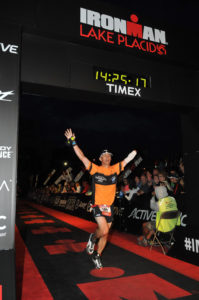
A year and one week ago I should have been completing my third Ironman triathlon in Lake Placid, New York. Alas, it was not meant to be, after months of hard training, a bike accident five weeks before race day ended with a broken collarbone and shattered dreams.
A year later, on July 23rd, 2017 the cold shrill of my iPhone alarm cuts into my restless dream that I’d overslept and missed the start of the race. It was time to take care of some unfinished business. As I lay on the ground last year after being run off the road by a white delivery van, feeling the break in my collarbone with my right hand and realizing my Ironman ambitions were done for, I had no shadow of a doubt that I’d be back to try again this year, to not do so was inconceivable. However, it’s been tough training at Ironman intensity for the second year in a row. There’s a reason for the three-year gap between my races to date. It takes a year for me to recover from the incessant training schedule, a year to forget the pain of the whole ordeal and a year to train for my next Ironman after the brilliant idea pops back into my head that I should do another one. I struggled the early part of this year with my motivation level; my usual iron will deserting me as I failed to build any training rhythm until April, at which point I was three months behind schedule. “Oh well,” I thought to myself, “no chance I’m going to be overtrained for this race.”
All through April, May, June and right up to race day the specter of last year’s accident clung to me like a homunculus. The slightest wobble on my bike or awkward step on a run flooded me with thoughts of falling and breaking or twisting something. Yet, here I am at 4 am race morning, undertrained for sure, but fighting fit and ready to swim 2.4 miles in Mirror Lake, bike 112 miles through the Adirondacks and run 26.2 miles out and back from Lake Placid. The oldest Ironman event in the U.S. outside of the World Championship in Kona, Hawaii, Lake Placid is recognized as both a beautiful and daunting course with close to 7000 feet of climbing on the bike and over 1600 feet of climbing on the run.
Today though, the weather gods delivered a near perfect day, overcast and slightly cool. Quite a relief since earlier forecasts had called for rain and even thunderstorms. Waves of anticipation, or perhaps trepidation, churned my stomach as I stood on the shore of Mirror Lake surrounded by close to 2500 other wetsuit-clad Ironman wannabes of all shapes, sizes, and ages. Blocked by the mass of bodies lay the 1.2-mile swim course, the lake was an official 74 oF, quite balmy compared to the sub 60 oF temperatures of my last Ironman in Lake Tahoe. The ringing blast of a cannon marks 6:30 am and the start of the race for the pro field. Ten minutes later, a second blast signals the start for the rest of us. I cautiously, yet optimistically, have seeded myself towards the back of the wave of athletes hoping to finish their swim in under one and a half hours, a satisfying time for me given I only have the one hand. The mass of bodies ahead of me begins to jostle its way towards the swim start, I fit my goggles and sneak one last look at the line of yellow buoys marking the first leg of the course, thrashing swimmers already stretching away into the distance.
I have one goal in mind, to get on and stay on the underwater cable that extends the entire length of the course. About four feet under the surface this guideline will keep me swimming true instead of my usual zig zagging that I tend to do. Of course, I’m not the only one with this thought in mind, and so the battle begins to see who can claim the line as theirs. Triathlon swims are not for the faint-hearted, I’ve been kicked, grabbed, swam over and even had my shoulder dislocated in the melee of a swim start. A little argy-bargy secures my position just to the left of the line, and onwards I swim, head down. A thousand yards out a red buoy marks the first 90o turn and all the swimmers who have been swimming parallel with me now converge to make the turn. Like spawning fish in a shallow pool, we jostle into and over each other, pulling and pushing to make it past the constriction point. Keep calm. Keep breathing. A left hook catches me off guard and unseats my goggles, flooding my right side. No time to stop. Keep calm. Keep breathing. Keep swimming. Stop, and the hoard of swimmers behind me will bury me alive. Fifty yards and the second red buoy marks the next 90o turn and the straightaway back to the start. I focus on maintaining my position over the underwater cable, swimming into each of the eight yellow buoys marking the course and rounding the end of the pier to swim to the beach. Ahead and beside me, swimmers sway in unison as they emerge from the water on unsure legs and run the twenty sandy yards to enter the water again for the second loop. Glancing at my watch I spy my time is 42 minutes, if I can maintain this pace, it’ll be my fastest swim ever. I continue to count my strokes as I head back down the course, 1, 2, 3, 4, 5, 6, 7, 8, 1, 2, 3…and, so it goes on, looping over and over, distracting my mind from the exertion of the swim. The red turn buoy approaches again, and this time I make it past unscathed. Around the second red buoy and just the final straight to go. Wham! An errant fist unseats my goggles, and I have no choice but to pause and reseat them. Looking at my wrist, I see my time; I’ve slowed down compared to the first loop. “Come on, swim harder, nearly there.” My counting accelerates as my strokes increase from 36 to 38 per minute.
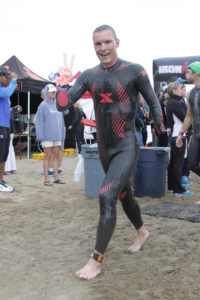
I stumble out of the water on to the beach and across the timing mat laid in the sand, 1 hour 29 minutes, only two minutes slower than my fastest swim and that was in Cozumel with a current. My water-logged and deadened ears come alive with the cheering and screaming of the spectators surrounding the beach and lining the chute to the transition area. Ahead, swimmers, in various states of disrobement, lay on the ground as volunteers tug and pull their wetsuits off. In no time I’m running along the beach with my wetsuit in hand or rather stump and weave around the athletes that are taking in the spectacle of it all. It’s 8:20 am.
Entering a sauna of a changing tent that is chock full of steaming bodies intensely focused on the job at hand, I grab the first empty chair I see close to the entrance and strip off my tri suit and dry myself with my trusty blue microfiber towel. No time to waste—the memory of my 24-minute transition in Lake Tahoe haunts me. Bike shorts on, bike jersey on, prosthetic arm on, helmet on, I’m ready to go. Stuffing my wetsuit and swim gear into my transition bag, I hand it to a volunteer and jog to the far end of the tent and into the fresh morning air, “maybe I should have put that base layer on after all,” but there’s no time for second thoughts now.
The bike racks, once chock full of bikes are now half empty. I’ve got some catching up to do despite a strong swim; only having the one hand will always put me at a disadvantage on the swim. A quick pit stop to relieve myself of the lake water unintentionally guzzled and I grab my bike to mount up for the 112-mile ride. Out of transition, a short downhill gives me a few moments to collect my thoughts after the bustle of transition. The words I read this morning from my coach, Paul, are foremost in my mind:
…you should be able to target 130-135 watts on the bike and still be able to have an effective run…[this] should feel very easy at the beginning of the bike and progressively feel harder as the 112 miles progresses, but never to the point that it feels unsustainable.
— Paul
Now my months of training kick in, and it’s all down to my nutrition, pace and discipline on the bike. Go too hard on the bike and my run will fall apart, just as I’d experienced with my first Ironman in Cozumel in 2010, I pushed hard, clocking a time of 6 hours 46 minutes, yet I cratered on the run, walking the last 8 miles. I have a trick up my sleeve, my new PowerTap P1 Pedals that allow me to monitor my power output through the ride, “the key is to pedal steady, with as few spikes as possible,” admonishes Paul in my mind. Not easy on a course with nearly 7000 feet of climbing and the climbing begins at mile three. If it weren’t for my power pedals I’d be pushing over 200 watts to keep up with the riders passing me. Instead, I hold back. “Just you wait,” I mutter as each rider passes me on the hill, “let’s see how chipper you feel on the second loop.” Discipline is telling me to ride my own race and not worry about anyone else; there’s still 100 miles of riding ahead and a marathon to boot. My ego rails against this cage with each passing rider. Cresting the hill at mile 10, I shift gears and climbing gives way to a 45 mph, sphincter tightening descent into the village of Keane. My rented 808 Zipp race wheels (with very wide rims) magnify each gust of wind, shaking my bike and pushing me towards the meridian as every muscle in my body braces nervously. At least I’m passing other riders as I tuck down on my aerobars to minimize wind resistance. The resonant “whoosh, whoosh” of my Zipp wheels and dull reverberating clunk of every gear change ring out. Even if they don’t make me go any faster, these wheels sure sound good.
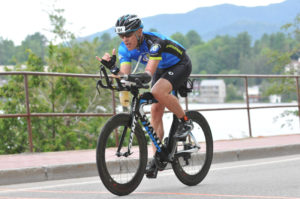
At the bottom of the descent, I enter Keane and make a left hand turn onto the relatively flat 20-mile ride past Jay to the turnaround at Ausable Forks and back to Jay again before a long, hard slog uphill to Lake Placid. This relatively flat 20-mile stretch is my favorite part of the course, no traffic lights, no stop signs; an opportunity to crouch into my aerobars, put my head down and pedal. Such a delight after months of training rides out of Manhattan, over the George Washington Bridge and along 9W, with its incessant stops and never-ending traffic. I keep my power output in the 135-140 watt range and constantly sip water, pop salted pistachios and nibble my Juice Press Gladiator Cookies. Nutrition, pace, and discipline. Maintaining an intake of 200-300 calories an hour is going to get harder as the day progresses. Approaching mile 34 the flat road quickly gives way to a steep climb that marks the beginning of the 20-mile jaunt from Jay back to Lake Placid and the start of the second loop. Arriving at the Olympic Sports Complex, I clock my time for the first loop at 3 hours 23 minutes. “If I maintain that pace I’ll do the bike in under 7 hours,” I mentally congratulate myself, “that’ll put me in prime position to finish the race in under 14 hours”. Only stopping briefly at the Special Needs area to restock my nutrition, I’m off. As Paul had predicted, maintaining a steady power output was getting progressively harder even on the flat, yet my discipline on the first loop was paying off. At mile 90 I’m passing more and more riders as they recover from each climb while I maintain a steady power output. Descending into Lake Placid for the last time the cheers and screams of the spectators erupt once again, I can’t help but smile, “112 miles down, just a marathon to go.” Nowhere else could the words “just a marathon to go” elicit a smile except at an Ironman. The bike has taken me 7 hours 8 minutes, just shy of my 7-hour goal, but I’ve improved my overall rank by 254 places, moving from 1710 to 1456. Now it’s time to see if my discipline pays off. It’s coming up to 4 pm.
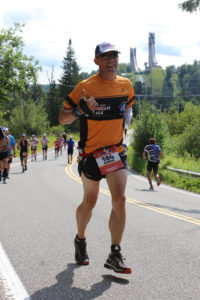
With the 9-hour mark approaching, to beat 14 hours I need to complete the run in under 5 hours. Running is far from being my strongest pursuit. I know I’m going to be slower than most in the swim, but there’s something about the monotony of swimming that allows me to zone out as I count my strokes. Biking is my favorite, my legs pump rhythmically, the wind rushes past my face, and there’s a sense of satisfaction that comes from human-powered speed over the ground. But running, running is just a grind. Maybe it’s because of the muscle tissue I lost from both legs as a result of my electrocution 11 years ago, or perhaps I just need to train harder. Rarely have I ever zoned out while running and with 1600 feet of climbing ahead it’s unlikely I’ll be zoning out today. Barring a catastrophe, it looks like I’ll smash my previous Ironman best of 14 hours 45 minutes that I set in Cozumel 7 years ago on a much easier course. But can I do it under 14 hours? My best run time was at Ironman Lake Tahoe, 5 hours 45 minutes. My run at Ironman Cozumel was terrible, over 6 hours. Pulling off a 5-hour run based on that track record is by no means a certainty. Just focus on each mile as it comes. I settle into my 9-minute run, 1-minute walk intervals. At mile 6 mile I’m an hour in; an average of 10:00 minutes per mile, a fast pace for me. I can feel the fatigue seeping into my road-weary legs as I struggle to take anything into my churning stomach. Passing mile 13 I’m halfway there, but my pace has slowed to 11:20 per mile. My body desperately wants to walk yet I urge myself to complete “just” another mile, then another, “I’ll walk after this mile,” I tell myself, yet never do. My pace is slowing, 11:30, 12:00, 12:30, 14:00 and at mile 23 I cave in and walk, I’m done. Hopes of breaking 5 hours recede into the distance. It takes 15 minutes to walk mile 24, and then something magical happens.
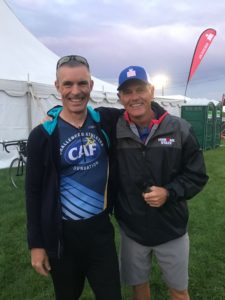
The last brutal climb to the Olympic Sports Complex is behind me, the energy of the crowd seduces me, I hear my name called out by spectators cheering me on, “you’re nearly there,” they shout. The energy intensifies, and I look at the radiant faces of each stranger holding out their hand for a high five. My legs start to pick up, and I break into a run again. “It’s not over yet,” I tell myself, “you can do it.” Mile 25 passes in 11 minutes 36 seconds, and still my legs go faster. It’s as if I’m Forrest Gump running from the bullies, braces breaking away from my legs and freeing them to run. I lean forward to keep up with them as mile 26 passes in 9 minutes 53 seconds. Entering the Olympic speedskating oval that today doubles as the finish chute for Ironman Lake Placid the crowd crescendos, shouting, screaming, banging and stomping, their energy carrying each athlete across the line. White light electrifies the last 50 yards as I hear Mike Reilly, the Voice of Ironman, announce:
Keiron McCammon, you are an Ironman!
I didn’t quite break the 14-hour mark that day. I finished the run in 5 hours 2 minutes and the race in 14 hours and 39 seconds. I beat my previous best by 44 minutes, set seven years ago on a much easier course and my run was 43 minutes faster than my best time from Lake Tahoe four years ago. I made up 304 places on the run to finish 1152 overall and most importantly to finish 1st in the Physically Challenged division! I guess that discipline paid off after all.
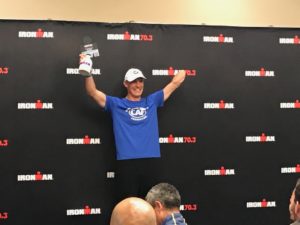
If you’d like to support my efforts and donate you can click the button below.
Help me raise $3,500 for the Challenged Athletes Foundation*
*80 cents of every dollar goes to support those with physical challenges
